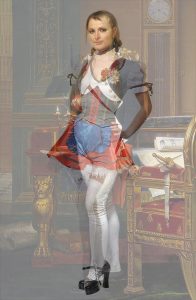Take one look at Deborah Oropallo’s artwork, and you haven’t seen anything. This Bay Area artist’s hybrid prints are so intricate that one’s eye must linger and settle to take it all in, peeling away the layers to extract a narrative.
And that narrative is certainly a unique one. In a lecture at the Berkeley Art Center this past Saturday, Oropallo addressed a crowded room and dissected both the technical and creative process of creating her large print pieces. For Oropallo, these pieces are sometimes a constant work in progress; she can always find some way to add or subtract or distort the various pieces that make up her work. Add a gas mask, subtract some bunny ears, and you get a whole new story. Take her recent series entitled “Guise,” nineteen prints that overlay the images of females in sexy Halloween costumes on top of 17th-and-18th-century portraiture, and, in doing so, explore the relationship between gesture and seduction, pose and power.
On the technology she used to create such strange fusions, Oropallo notes on Gallery 16’s website, “I do not want to just repaint an illustration of what the computer can do, but to push the pixels themselves as paint, and to layer imagery and veils to create depth and volume. Like painting, this process can engage nuance and subtlety. It also has the ability to alter an image in a way that no other medium can deliver or predict.” Thus, rather than seeing this technology as taking away the “artist’s hand,” as one audience member suggested, Oropallo views it as merely another medium with which to manipulate imagery to create her own narrative, one that is freeing rather than prohibitive, as it allows her a freedom of time and a control that was never available in traditional print mediums. “Besides, my hand is technically controlling the computer anyway,” Oropallo joked.
Asked if she considered herself a feminist, as her work is often interpreted through such a lens, the answer was a polite but firm no. Oropallo explained that she does not intend for her work to spell out a certain political or social ideology. Rather, she goes where her artistic curiosity and interests take her, and it just so happens that the path leads to the same sorts of subject matters that certain interest groups are drawn to as well: issues of women and presentation, bondage, sexuality and power or lack thereof.
We see these themes unfold throughout her work, from the delicate calf extended out in the piece, “Napoleon” — a calf which belongs to both the proud, stately Napoleon, as well as the pigtailed, unmistakable female figure superimposed and layered over him. The two are similar in stance and gesture and so intermingled as to be indistinguishable: an emperor projecting his power, a sexualized female projecting something very different, or perhaps the same. With these prints, Oropallo makes her viewers question and revisit what draws us to these two dichotomous yet harmonious images.
And with any art that is based on the manipulation of preexisting work, Oropallo must deal with the issues of acquiring rights and discerning the line between new and old. Thankfully, Oropallo credits her gallery for granting her access to the famous portraits that are used in “Guise,” so she’s overcome such hurdles for now. But for Oropallo and other artists like her who dabble in the digital medium, this frontier comes with its own new difficulties involving property and interpretation, despite granting more creative freedom in other regards. No doubt, for Oropallo, such hurdles are worth the final result

